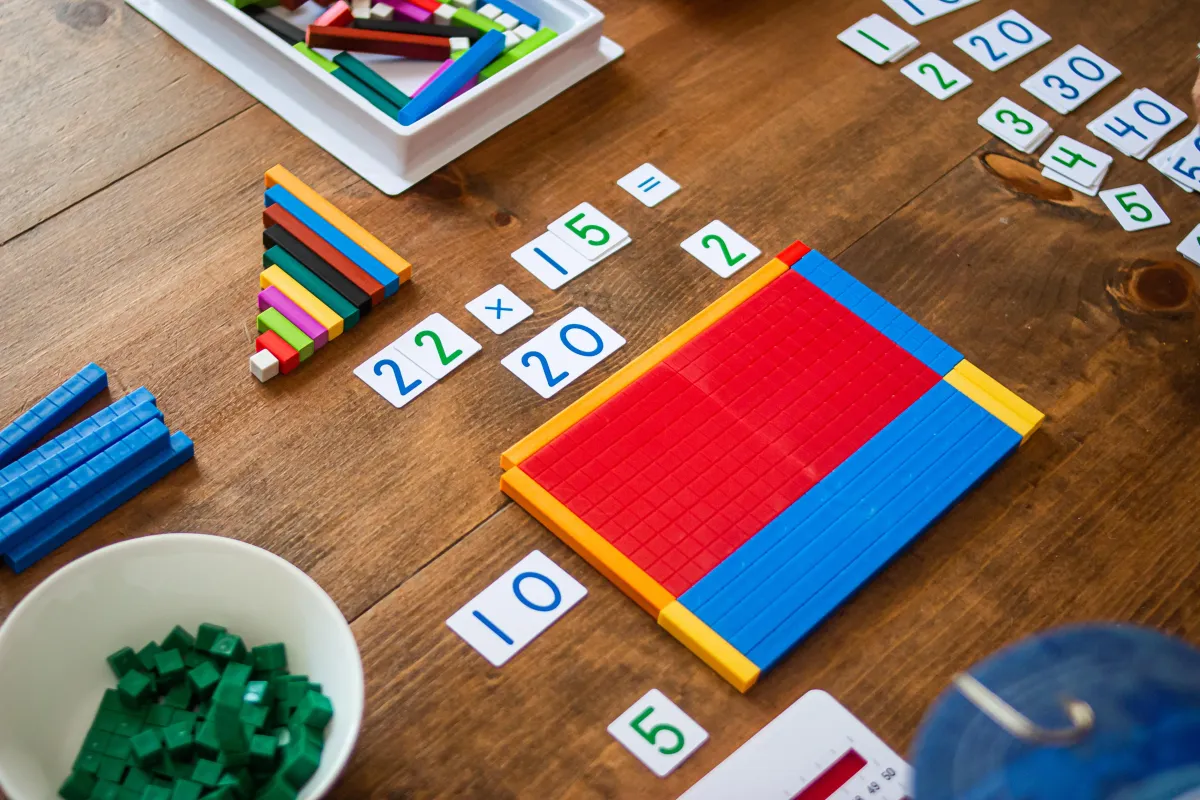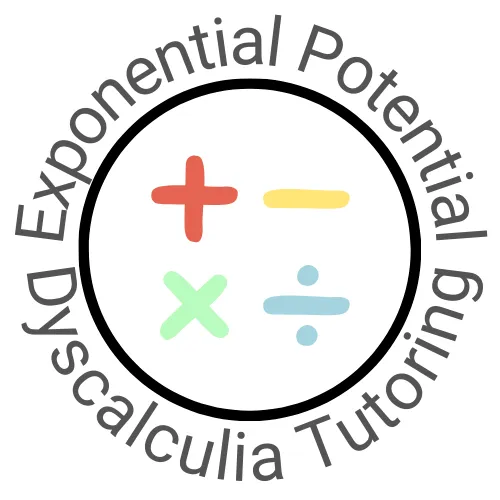Contact Us
Blog

What is Multisensory Learning
“The only way to learn mathematics is to do mathematics.” - Paul R. Halmos
Multisensory Learning
Imagine learning about a new culture; your only resource is a well-written book with excellent imagery and descriptions.
After reading the text, you become interested in knowing more about the art and architecture of this culture, so you seek out books containing beautiful color photographs. You want to learn more about their music, so you download and listen to several compositions that represent this culture well.
Finally, if you immerse yourself in the culture, you can experience all it offers: the landscape, food, music, art, architecture, geography, climate, and language.
How much better will you know this culture after an immersive sensory experience from traveling there? Will you be able to recall this knowledge years later?
What is multisensory tutoring?
Multisensory tutoring is an instructional approach that involves engaging multiple sensory modalities simultaneously in the learning process.
In multisensory tutoring, various techniques present information to accommodate different learning styles by integrating visual, auditory, kinesthetic, and tactile elements to enhance the learning experience.
This approach is often used in educational settings for individuals with learning differences or disabilities, such as dyslexia, dyscalculia, or attention deficit disorders.
This approach can be especially beneficial for those with learning disabilities, as it taps into different sensory channels to enhance comprehension and retention of information.
Which Senses are Targeted?

Visual (Seeing)
What is it?
Using images and visual aids to support learning.
How is it used?
To provide visual learning opportunities, consider using visual aids (charts, graphs, diagrams, and drawings), manipulatives (beads, counters, and blocks), and technology (educational apps and virtual manipulatives).
How does it help?
Visual learning promotes concrete understanding, enhances memory and pattern recognition, increases engagement, and improves organization and focus.
Examples:
Use manipulatives like beads or counters to represent addition and subtraction facts.
Color-code steps of a math problem to enhance each part of the process.
Illustrate word problems to make the story more concrete and visually understandable.
Create visual summaries of lessons.
Engaging the visual sense in multisensory tutoring for students with dyscalculia involves using a variety of visual aids and techniques to make math concepts more understandable and memorable.
By integrating these visual strategies, multisensory tutoring can significantly enhance the learning experience for students with dyscalculia, making math more accessible and less daunting.

Auditory (Hearing)
What is it?
Using sound to enhance learning.
How is it used?
Employing clear verbal instructions, mathematical songs and rhymes, technology with auditory feedback, discussions, mnemonics, and audio recordings or read-alouds can enhance your dyscalculic student's learning.
How does it help?
Auditory learning enhances understanding, improves memory, and increases engagement.
Examples:
Sing skip counting songs to aid in memorizing multiplication and division facts.
Have your student play the role of teacher and explain a new concept.
Tell stories that involve math.
Invent mnemonics to help you learn how to solve a multi-step math problem.
Play online math games with audio feedback.
Engaging the auditory sense in multisensory tutoring for students with dyscalculia involves incorporating sounds, music, verbal instructions, and auditory feedback to help students understand and retain math concepts.
By integrating these auditory strategies, multisensory tutoring can create a more effective learning environment for students with dyscalculia, helping them better understand and retain math concepts.

Tactile (Touching)
What is it?
Involving the sense of touch in the learning process.
How is it used?
To engage the tactile sense in your child’s learning environment, employ manipulatives (base ten blocks, Cuisenaire rods, and counters), interactive math tools (balance scale or abacus), hands-on activities (writing in rice, or tracing sandpaper numbers), math games and puzzles (tangrams, cards or dice games), and real-life applications (cooking, measuring, counting money).
How does it help?
Engagement of the tactile sense in learning math will encourage concrete understanding, promote active engagement, enhance memory and retention, and reduce math anxiety.
Examples:
Model addition and subtraction problems using base ten blocks or Cuisenaire rods.
Play “store” and have your student purchase items or act as the cashier and make change.
Practice writing numbers in various substances (sand, rice, dry beans, shaving cream) or on other surfaces (paintbrush with water on a fence, sidewalk chalk, dry-erase markers).
Work on the concept of symmetry using tangrams.
Use an abacus or Rekenrek to work on understanding quantity.
Bake cookies and discuss fractions as you measure items.
Involving the tactile sense in multisensory tutoring for students with dyscalculia involves incorporating hands-on activities and materials that students can touch and manipulate. This helps make abstract math concepts more concrete and understandable.
By incorporating these tactile strategies, multisensory tutoring provides a rich and varied learning experience that can significantly benefit students with dyscalculia. It helps them understand and enjoy math more.

Kinesthetic (Moving)
What is it?
Using movement and physical activity to encourage learning.
How is it used?
The kinesthetic sense can be included in the learning process by employing hands-on building, movement-based activities, physical manipulatives, gestures, physical exercise, and real-life activities.
How does it help?
Employing the kinesthetic sense fosters active engagement, promotes concrete understanding, improves memory and recall, improves focus, and reduces anxiety.
Examples:
Invent hand movements or gestures to use in math story-telling.
Play active games like hopscotch. Vary the rules to incorporate skip counting.
Make a life-sized number line and have your student move along it to solve problems.
Incorporate dance or rhythm to work on sequences.
Time, measure, or record performances from your child’s sport and discuss the math involved in their activity.
Engaging the kinesthetic sense in multisensory tutoring for students with dyscalculia involves incorporating movement and physical activities into learning to help students understand and retain math concepts.
By incorporating kinesthetic strategies, multisensory tutoring can provide a dynamic and effective learning experience for students with dyscalculia, helping them to grasp and retain math concepts through movement and physical activity.
By leveraging these different senses, multi-sensory tutoring provides a more holistic approach to learning, catering to the unique needs of students with dyscalculia. This approach helps them grasp and retain math concepts more effectively by engaging their brains in various ways, making learning more accessible and enjoyable.

Why Does a Multisensory Approach Help?
Engages Multiple Areas of the Brain
Different parts of the brain are responsible for processing various types of information. For example, visual information is processed in one area, auditory information in another, and tactile information in another.
When multiple senses are involved in the math learning process, more areas are activated, allowing the brain to make connections more easily and understand concepts better.
Reinforces Learning Through Different Channels
Learning the same information through different senses can reinforce the same concept in various ways. This is called “multisensory integration.”
If students don’t understand a math concept through one sense (like just hearing it), they might understand it better through another sense (like seeing or touching it). This multiple reinforcement helps solidify understanding.
Improves Memory and Retention
Using multiple senses simultaneously helps with encoding information into memory more effectively.
Students are more likely to remember math concepts when they have learned them through multiple senses. For example, they might remember a math song (auditory) or how moving objects to count (tactile) felt.
Makes Learning More Engaging and Fun
Multisensory activities are often more interactive and enjoyable, which keeps students interested and motivated to learn.
Engagement and motivation are critical to effective learning. When we are engaged and having fun, the brain releases chemicals like dopamine, which helps with learning and memory.
Helps With Focus and Attention
It is common for students with learning difficulties, including dyscalculia, to struggle with maintaining focus and attention. Multisensory activities can help by providing different ways to stay engaged.
By involving their whole body and multiple senses, students can focus better and stay on task longer than traditional, passive learning methods.
In Summary
Using a multisensory approach, we tap into the natural way the brain learns best—through a rich and varied experience. This method is especially beneficial for students with dyscalculia because it helps them overcome their unique challenges with traditional learning methods. It turns learning into a more dynamic and successful process.
Are you ready to see the magic of multisensory learning in action? Imagine combining the power of touch, sight, sound, and movement to transform math from a daunting challenge into an engaging adventure for your child.
But don't stop here! Dive deeper into the world of math games, a perfect complement to the multisensory approach. In my previous blog post, I discuss the importance of incorporating games into math learning.
Visit the blog [here] to discover how math games can further enhance your child’s learning experience and where you can grab your free download today! Let's make math an exciting journey together!


